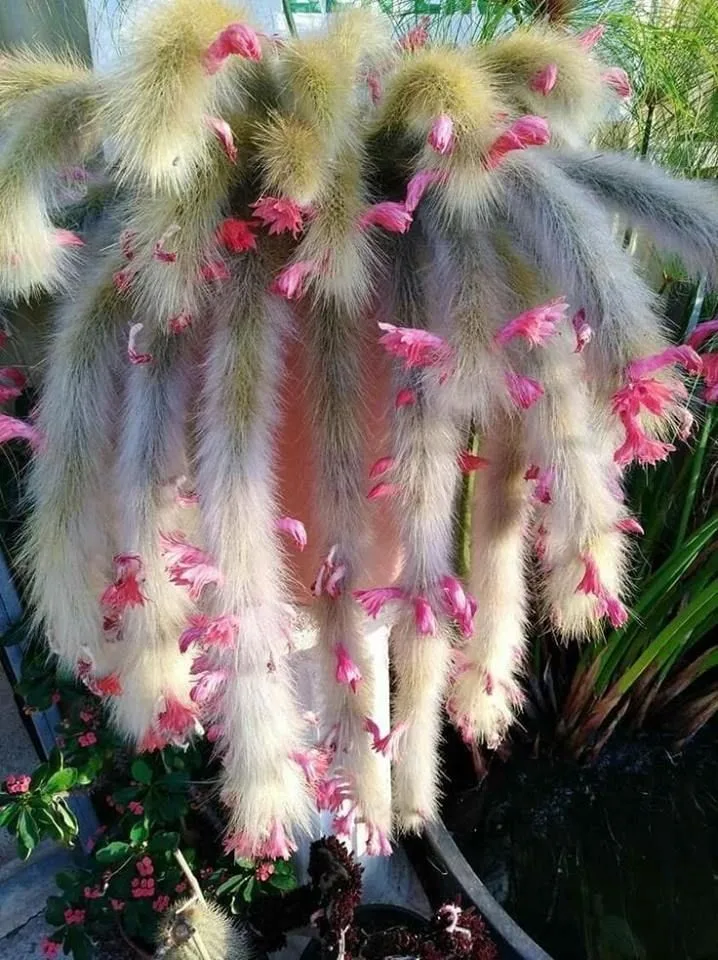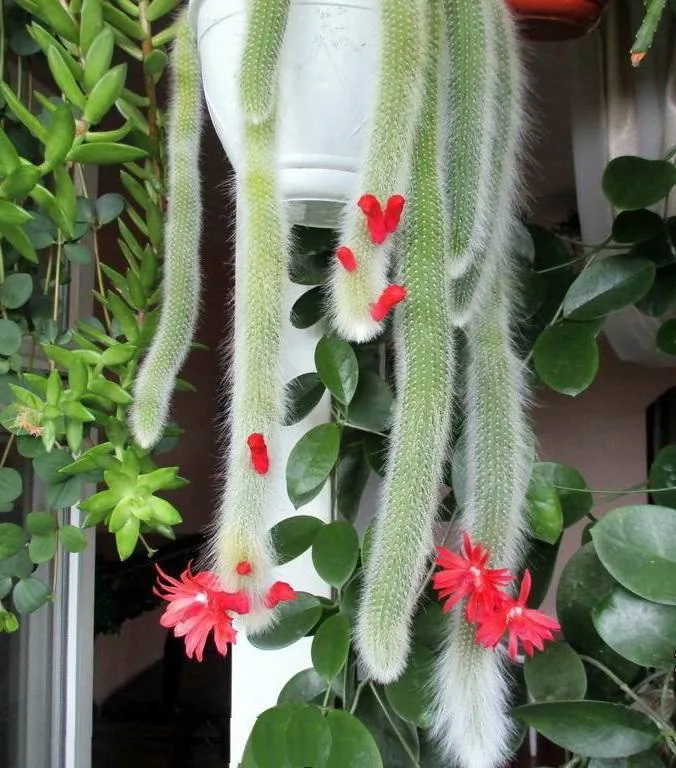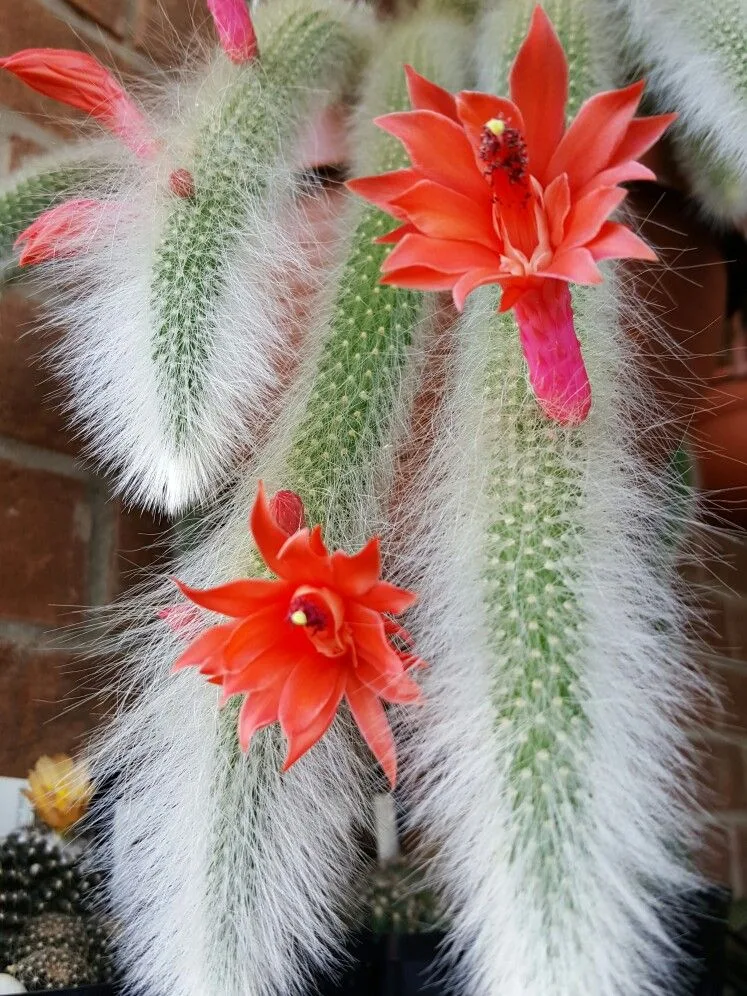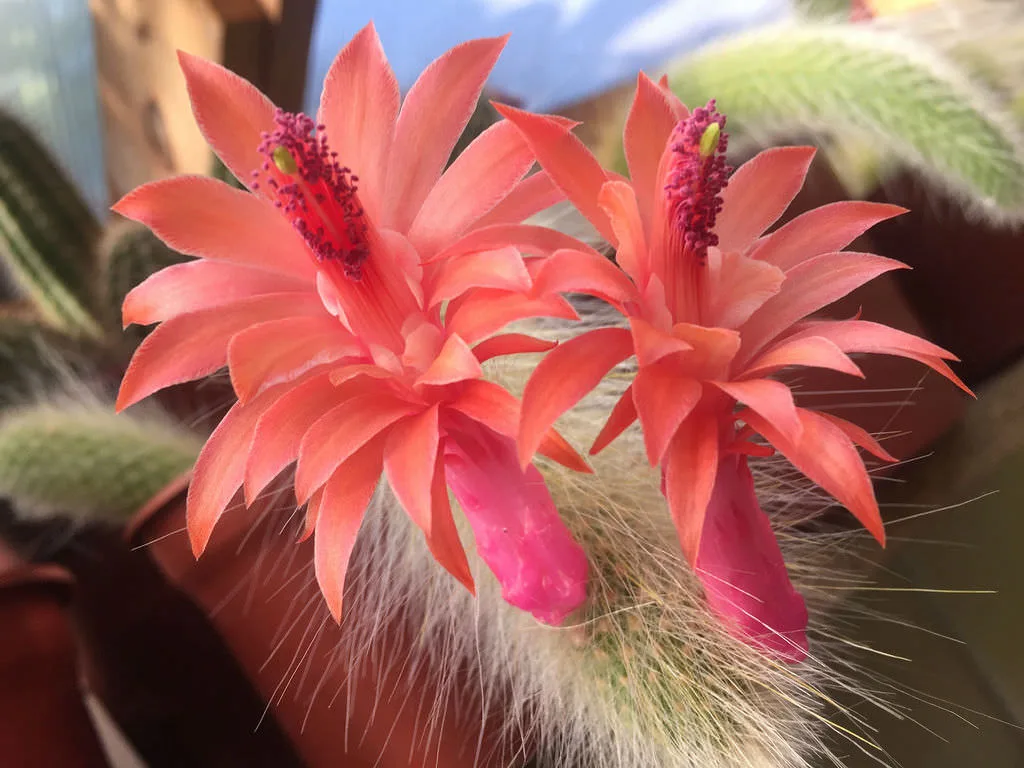index
Introduction
The Monkey Tail, scientifically known as Hildewintera colademononis, is a fascinating plant that captivates lovers of succulents and cacti. Originally from the mountainous regions of South America, this species stands out for its unique appearance and intrinsic characteristics. Its popular name, “Monkey Tail”, is a reference to the peculiar shape of its segments, which resemble the tail of a primate.
This succulent has segmented, fleshy stems, often blue-green in color, adorned with small thorns that give the plant an aura intriguing. The stacked segments give the impression of a monkey’s tail, hence the affectionate name. In addition to its captivating aesthetics, the Monkey Tail is known for its resistance to adverse conditions, making it a popular choice for beginner gardeners and plant collectors.
The Meaning of the Monkey Tail Succulent
The Monkey Tail carries with it a special symbolism in various cultures. Its resilience and ability to thrive even in challenging environments are often associated with resilience and tenacity. In some traditions, the plant is seen as a good luck charm, attracting prosperity and resisting life’s obstacles. Its scientific name, Hildewintera colademononis, can also evoke local myths or legends, further enriching the narrative around this fascinating succulent.
| Common Name | Monkey Tail |
|---|---|
| Botanical Name | Hildewintera colademononis |
| Family | Cactaceae |
| Type of Plant | Succulent |
| Adult size | Small to medium |
| Solar Exhibition | Full sun |
| Soil Type | Well drained |
| Soil pH | Slightly acidic to neutral |
| Flowering Season | Spring to summer |
| Color of Flowers | Varies (usually vibrant) |
| Native Area | South America, mountainous regions |
| Toxicity | Non-toxic |

How to Care for a Monkey’s Tail
The Monkey’s Tail (Hildewintera colademononis) is a charming succulent that, with proper care, can thrive and adorn your space with its unique beauty. Here are some essential tips to ensure the well-being of this fascinating plant:
Light
Suitable Sun Exposure: Monkey Tail thrives best in places with direct, intense sunlight. Position the plant in a place where it receives at least 6 hours of daily sunlight. Avoid prolonged exposure to dense shade to ensure healthy growth.
Soil
Well-drained soil: These succulents appreciate soil that provides excellent drainage. Use specific substrates for cacti and succulents, adding sand or perlite to ensure good aeration and prevent water from accumulating in the roots.
Water
Moderate Watering: The Monkey Tail is drought-resistant and prefers slightly dry soil between waterings. Avoid overwatering, allowing the soil to dry out completely before watering again. Make sure the pot has drainage holes to prevent water from accumulating.
Temperature and humidity
Moderate Climate: These succulents appreciate moderate temperatures. Avoid exposure to frost and extreme temperatures. As for humidity, the Monkey Tail tolerates drier environments, but benefits from a balanced relative humidity.
Fertilization
Light Fertilization: Fertilize the Monkey Tail during spring and summer, the times of greatest growth. Use a balanced fertilizer, formulated for cacti and succulents, and apply it sparingly. Avoid excess to avoid damaging the plant.
By following these care guidelines, you’ll be providing Rabo de Macaco with the ideal conditions for healthy, lush growth. Remember to observe the specific needs of your plant and adjust the care as necessary.

How to Make Monkey Tail Succulents
If you’re passionate about Monkey’s Tail (Hildewintera colademononis) and want to expand your collection or gift this charming succulent to friends, propagation through cuttings is an exciting option. Follow this step-by-step guide to create your own healthy cuttings:
Choice of Segment
1. Select a Healthy Segment: Choose a healthy Monkey Tail segment for the seedling. Make sure it is at least a few centimeters long to ensure good development.
Soil Preparation
2. Use a Suitable Soil: Prepare a well-drained substrate, ideally a specific mix for cacti and succulents. Add sand or perlite to improve soil aeration.
Removing the seedling
3. Remove the Segment Carefully: With a sharp knife or scissors, cut the chosen segment close to the base of the mother plant. Make sure to make a clean cut to minimize stress on the plant.
Healing
4. Let the seedling heal: Let the freshly cut seedling dry out and heal for a day or two. This reduces the risk of infection and promotes effective healing before planting.
How to Plant the Monkey Tail Succulent
After preparing the seedling, it’s time to plant it in its new home. Follow these steps to ensure a smooth transition:
Planting in the ground or a pot
1. Site selection: Select a sunny spot for planting or choose a pot with good drainage. Make sure the soil is dry before proceeding.
Burial
2. Plant the seedling: Make a small hole in the ground and insert the seedling, ensuring that it is firmly planted. Avoid burying it too deeply; maintaining the original height of the segment is crucial.
Initial watering
3. Water with caution: After planting, water the seedling carefully, avoiding waterlogging. Allow the soil to dry out between waterings to promote a healthy root system.
Initial care
4. Protect Against Strong Sun: In the first few days after planting, protect the seedling from intense direct sunlight. This helps it adapt to the new conditions.
With these instructions, you’ll be able to successfully propagate and plant Monkey Tail seedlings. Enjoy the process and watch your new plants grow and flourish over time.

Most Common Pests and Diseases
When growing the Monkey Tail (Hildewintera colademononis), it’s important to keep an eye out for possible pests and diseases that can affect the health of the plant. Here’s a list of the most common ones:
- Mites:
- Symptoms: Fine webs and yellowing of the leaves.
- Solution: Use a jet of water to remove mites. If necessary, apply neem oil.
- Bugs:
- Symptoms: White spots and sticky secretions on the leaves.
- Solution: Remove the mealybugs by hand and use natural insecticides.
- Root Rot:
- Symptoms: Soft plant base and discoloration.
- Solution: Reduce watering, replant in well-drained soil and cut off infected parts.
- Fungi:
- Symptoms: Dark spots on the leaves and abnormal growth.
- Solution: Remove affected leaves, improve ventilation and avoid watering the leaves.
- Excess Moisture:
- Symptoms: Wilted leaves and rot.
- Solution: Adjust the watering and make sure the soil has good drainage.
Common Problems and Their Solutions
In addition to specific pests and diseases, some common problems can arise when caring for the Monkey Tail. Here are some guidelines for dealing with these issues:
Yellowing of the leaves
Cause:
- Excessive sun exposure or lack of nutrients.
Solution:
- Relocate the plant to an area with more filtered sunlight or provide a balanced fertilizer.
Stiolation (Excessively elongated growth)
Cause:
- Lack of adequate lighting.
Solution:
- Move the plant to a brighter spot or use artificial light if necessary.
Flaccid stems
Cause:
- Lack of water or excess humidity.
Solution:
- Adjust the frequency of watering to maintain a healthy balance.
By paying attention to these signs and applying the suggested solutions, you can keep your Monkey Tail healthy and vibrant, ensuring successful cultivation over time.
Curiosities and Myths
Curiosities
Discover fascinating information about the Monkey Tail (Hildewintera colademononis) that may surprise even the most dedicated enthusiasts:
- Extreme Resistance: This succulent is known for its resistance to adverse conditions, being able to survive in the most arid and dry environments.
- Segmented Growth: The Monkey Tail grows in segments, giving it the distinctive appearance of a monkey tail. Each added segment contributes to its unique shape.
- Vibrant Flowering: During the flowering season, the Monkey Tail can surprise with its vibrant flowers, which can vary in color, adding a special touch to the plant.
Myths
Debunk misconceptions and myths that may surround the Monkey Tail:
“Requires Intensive Care”
Reality: Despite its unique appearance, the Monkey Tail is remarkably hardy and does not require intensive care. A balanced approach to light, water and soil is usually sufficient.
“It’s Toxic to Pets”
Reality: Contrary to some myths, Monkey Tail is considered non-toxic for pets. Nevertheless, it is advisable to monitor pets’ access to plants, as individual reactions can vary.
“Grows quickly”
Reality: Monkey Tail has a moderate growth rate. Although it is hardy, its growth rate is generally slower, making for a peaceful growing experience.
Exploring the curiosities and debunking myths helps improve understanding of the Monkey Tail, allowing enthusiasts to fully enjoy this unique succulent.

Conclusion
As we explore the fascinating universe of the Monkey Tail (Hildewintera colademononis), we discover a succulent that goes beyond its aesthetic peculiarity. Its unique characteristics, such as segmented growth and resistance to adverse conditions, make it an engaging choice for plant enthusiasts. By following specific care, such as providing adequate sunlight, using well-drained soil and managing watering wisely, we can ensure successful cultivation and admire its vibrant flowers during the flowering season.
By dispelling myths, we realized that Monkey Tail is not only a charming plant, but also easy to maintain, debunking the idea that it requires intensive care. Its limited toxicity to pets and moderate growth rate make for a rewarding gardening experience. In short, to grow Monkey Tail is to immerse yourself in a world of botanical curiosities, where beauty intertwines with resilience, providing a unique touch to any succulent collection. By adopting these practices and understanding the nuances of this captivating plant, we can truly appreciate and preserve the charm of the Monkey Tail in our green spaces.
Frequently Asked Questions
How many times a week do you have to wet the monkey’s ass?
The frequency of watering for the Monkey Tail varies based on factors such as climate, temperature and humidity. In general, it is advisable to water when the soil is dry, usually every 1-2 weeks, avoiding waterlogging to prevent root problems.
What is the monkey tail flower used for?
The Monkey Tail flower is not known for having a specific use or medicinal benefit. However, its main function is ornamental, contributing to the beauty of the plant during the flowering season. The vibrant and varied flowers add a decorative touch, making the Monkey Tail appreciated for its unique aesthetic.







